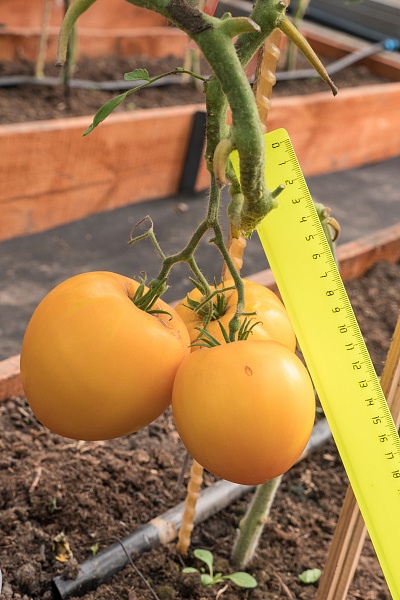
- Authors: Blokin-Mechtalin V.I.
- Year of approval: 2019
- Category: hybrid
- Growth type: indeterminate
- Appointment: fresh consumption, for juice
- Ripening period: mid-early
- Ripening time, days: about 100
- Growing conditions: for open ground, for film greenhouses
- Bush size: tall
- Bush height, cm: up to 200
The Yellow Empire is a bright sunny color tomato. In addition to the original color, they also have a very pleasant sweet and sour taste, look quite presentable, and contain a lot of carotenoids. The Yellow Empire has not only amazing taste, but also high productivity and early ripening of fruits, which attracts farmers so much.
Breeding history
The author of the Yellow Empire tomato hybrid is the breeder Blokin-Mechtalin V.I., known to many gardeners and professional farmers. Culture is its recent development, the hybrid was approved for use in 2019. Recommended for cultivation both in small private farms and for large-scale farming for subsequent transportation and sale. Can be grown both in open and protected beds, for example, in greenhouses, greenhouses.
Description of the variety
Hybrid indeterminate tomato is tall: its stems can reach a height of 2 m. The foliage is green, the plates are long. The first brush will be formed after 9 or 10 leaves, then clusters are formed every 3 leaves. From 5 to 7 fruits ripen in each cluster.
The main qualities of the fruit
First of all, the fruits of the Yellow Empire are rather large in size: on average, it is a 350-gram tomato, but you can also find a record 700-800 g. If unripe, the fruit has a light green appearance, then ripe will be a beautiful yellow color. Tomatoes have an unusual shape, reminiscent of a heart. The peduncle is articulated. The fruits are medium-silvery. Tomatoes have a beautiful golden glossy thin skin.
Taste characteristics
Sunny tomatoes are not only very beautiful, but also delicious. The sweet, sugary pulp has a pleasant texture and rich yellow color. Many people taste fruit flavors. Vegetables are used to make delicious salads and cuts, vegetable purees, as well as juices, ketchup and sauces. However, tomatoes are completely unsuitable for canning as a whole due to their impressive size.
Ripening and fruiting
Already 100-104 days after germination, the first harvest of fruits can be carried out. Fruiting lasts until the end of October.
Yield
Hybrid Yellow Empire refers to high-yielding tomatoes. The culture can bring, when grown in greenhouses, from 18 to 20 kg of fruits, and on open land, 14-15 kg from one m 2 of plantations.
The timing of planting seedlings and planting in the ground
For seedlings, sowing dates usually fall in February or March. Bushes are planted in a permanent place at the age of 50–55 days.

Growing tomato seedlings is an extremely important process, because it largely depends on whether the gardener can harvest at all. All aspects must be taken into account, from seedbed preparation to planting in the ground.
Landing scheme
The scheme for planting grown seedlings is 4 sprouts per 1 m 2. It is better to adhere to the scheme 50X50 cm.

Growing and care
It is better to purchase a special soil for cultivation, intended for tomatoes and peppers. However, if necessary, you can prepare the soil mixture yourself. To do this, you need to take 2 parts of turf, 1 part each of peat, compost and sand. When growing, you must adhere to simple rules:
- the formation of bushes in 2 trunks for the greenhouse and 2-3 in the open field;
- it should be watered only with warm, settled water not lower than 23–26 °;
- timely feeding with nitrogen-phosphorus-potassium mixtures, as well as organic matter.




A plant needs different micronutrients at each stage of growth. All fertilizers can be divided into two groups: mineral and organic. Folk remedies are often used: iodine, yeast, bird droppings, eggshells.
It is important to observe the rate and period of feeding. This also applies to folk remedies and organic fertilizers.


Growing regions
It is possible to grow the Yellow Empire tomato variety almost throughout the entire territory of our country. The culture takes root well not only in the northern regions, but also in the northwestern and central regions. And also in the regions:
- Volgo-Vyatsky;
- North Caucasian;
- Uralsk;
- on the middle and lower Volga.
You can also find plants in Western Siberia, Eastern Siberia, the Far East and the Central Black Earth region.

























































































